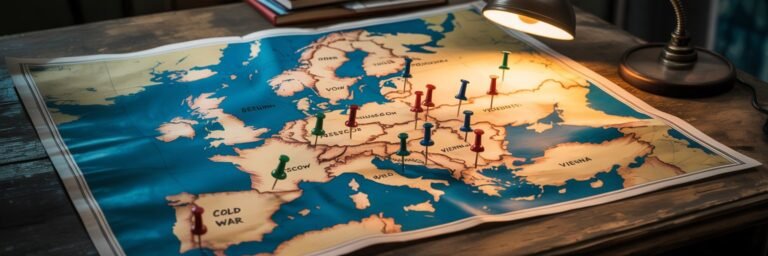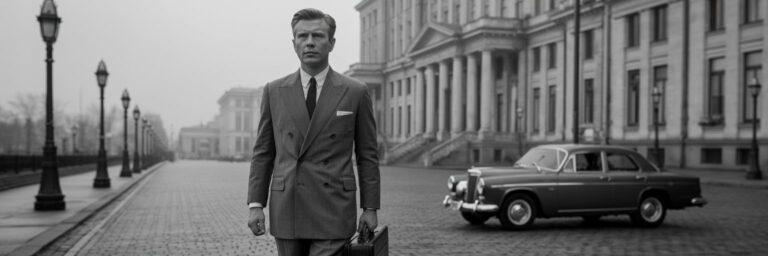INTRODUCTION
Frozen in the deep heart of the 20th century, the Cold War throbbed through the veins of global history. The United States and Soviet Union, two formidable superpowers, grew into entities of deep fascination and a source of apprehension for the world. Cutting across multiple continents, the Cold War was marked by a charged atmosphere of ideological conflict and political tension, spread across five turbulent decades from 1945 to 1991. Amidst the cloud of suspicion and mistrust, several men and women emerged as pivotal figures, their actions and decisions casting long shadows on the course of history. These key players had varied roles – some paved the path of diplomacy, while others fanned the flames of war, several others endeavored to draw curtains over this intricate ballet of domination and deterrence.
HISTORICAL BACKGROUND
To understand the actors in this grand play, we must delve into the world they inhabited. The end of World War II had left Europe decimated and split into spheres of influence. The US and Soviet Union emerged as superpowers, with distinctly differing ideologies. The Marshall Plan of American economic aid to Europe provoked Soviet resistance, planting the seeds of a trans-Atlantic conflict. The ideological chasm between Soviet Communism and American Capitalism transformed them into adversaries. Amidst this evolving tableau, we find our most influential figures, each shaping and being shaped by the Cold War.
THEORIES AND INTERPRETATIONS
Several dominant theories prevail regarding the motivators of the Cold War leaders. The first embodies the idea of ‘Realpolitik,’ postulating that national interest dominates international politics. Cold War leaders were strategists protecting their geographical and ideological territories. From a Marxist perspective, the Cold War was a result of capitalism’s inherent expansionism, painting the US leadership as driven by economic interests. Conversely, the ‘Ideological Conflict’ theory posits that the Cold War was fundamentally a conflict of ideologies, with figures like Joseph Stalin and Harry Truman acting as champions of competing value systems.
MYSTERIES AND CONTROVERSIES
The annals of Cold War history teem with mysteries and controversies. Among the most contentious is the Cuban Missile Crisis of 1962, where President John F. Kennedy and Soviet Premier Nikita Khrushchev tiptoed at the precipice of nuclear war. The Helsinki Final Act of 1975, signed by 35 nations including Gerald Ford and Leonid Brezhnev, remains controversial. Critics argue that it legitimized Soviet domination over Eastern Europe. The unexplained death of Secretary General Dag Hammarskjold of UN in 1961, who was instrumental in diffusing several Cold War conflicts, adds to the web of mysteries.
SYMBOLISM AND CULTURAL SIGNIFICANCE
The Cold War signified more than mere political and ideological conflict; it was a potent symbol of the polarities of human ethos, a mirror reflecting social, cultural, and philosophical chasms. Key figures like President Ronald Reagan or Soviet Secretary Mikhail Gorbachev became larger-than-life symbols, embodying American optimism and Soviet pragmatism respectively. Cold War narratives pervaded arts, literature, and media, shaping culture and collective consciousness, with icons like JFK becoming embodiments of America’s Camelot myth.
MODERN INVESTIGATIONS
Modern historiography often re-examines the Cold War era and its protagonists through the lens of declassified documents and fresh revelations. These documents, unveiling covert operations and secret alliances, provide a more nuanced view of the Cold War leadership. A renewed scrutiny finds that Agent ORION, Kim Philby’s intelligence leaks to the Soviets had far-reaching impacts, throwing into question the ethics of leaders like Winston Churchill and Eisenhower. Another intriguing revelation pertains to the ‘Venona Project,’ a secret US code-breaking initiative which, unbeknown to President Truman, had exposed several active Soviet spy rings.
LEGACY AND CONCLUSION
The Cold War left a profound legacy in its wake. The world, once bipolar, now shifted towards a dominant power, shrinking the global stage. Cold War leaders, for better or worse, have inscribed their indelible marks on the world map. Replicas of the Berlin Wall stand as symbols of the era, invoking memories of Kennedy’s inspiring words and the eventual fall of the Iron Curtain due to Gorbachev’s Glasnost. Many policies and geopolitical realities today are bequest of this era like the resilient North Atlantic Treaty Organization (NATO) or the tumultuous Middle-Eastern affairs.
Above all, the Cold War embodied a critical phase of humankind’s odyssey in the 20th century. The leaders of this epoch, with their strategic moves and ideological shrouds, shaped the world, accentuating the dance of power and principle, fear and rapprochement. Their legacies, a tapestry interwoven with threads of human endeavor and error, continue to shape the contours of contemporary history.






